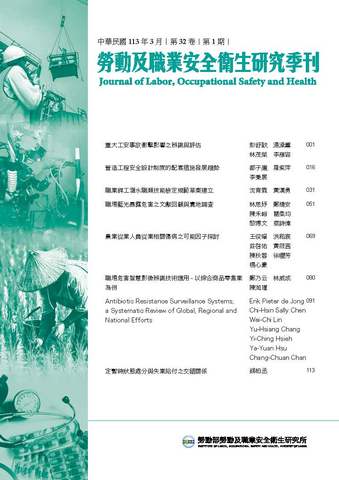 |
 本站僅提供期刊文獻檢索。 本站僅提供期刊文獻檢索。
【月旦知識庫】是否收錄該篇全文,敬請【登入】查詢為準。
 最新【購點活動】 最新【購點活動】
|
| 篇名 |
以ALOHA及WISER探討氯乙烯槽車之危害範圍
|
| 並列篇名 |
Investigate the Hazardous Range of Vinyl Chloride Tankers with ALOHA and WISER |
| 作者 |
許錦明、郭家宏 |
| 中文摘要 |
台灣因地理、交通及產業特性,化學品常須利用機動性高的槽車運輸,以灌裝方式補充製程所需化學品及清運。近年來國內槽車事故頻傳,事故型態主要為洩漏、火災、爆炸及形成氣雲等,在緊急應變及疏散管制的資訊建立與取得多直接採用緊急應變指南(Emergency Response Guidebook, ERG)之應變資訊。但在大當量、高活性或高毒性等情況下,實際危害範圍常會超出ERG所採用的固定經驗數值,可能誤判疏散距離而導致產生潛在危險。緊急應變無線資訊系統(Wireless Information System for Emergency Responders, WISER)是ERG的電子版。為方便使用,本研究選用WISER及ALOHA(Areal Locations of Hazardous Atmospheres),以2017年6月25日台氯氯乙烯槽車(約30公噸)事故為案例,探討兩者提供防護範圍的合宜性,以作為緊急應變規劃之參考。WISER數據庫提供氯乙烯化學品在洩漏後的無火隔離疏散範圍為800m,有火(含爆炸)的隔離疏散範圍為1,600m。經ALOHA模擬結果發現,氯乙烯ERPG-2(5,000ppm)為568m,小於WISER的800m範圍,但人體可感不適的濃度ERPG-1(500ppm)之影響範圍已達1,600m,超出WISER的800m範圍。依照美國環保署EPA(Environmental Protection Agency)開發的AEGLs(AcuteExposure Guideline Levels for Airborne Chemicals)標準其考量敏感人群:老人、病人及未成年人,AEGL-2(1,200ppm);以不造成不可逆傷害為原則;影響範圍達1,100m,為防止人員中毒,建議人員至少疏散至1,100m範圍之外。另外,10%LEL影響範圍為655m,小於WISER的800m範圍。爆炸與爆轟的0.5psi過壓影響範圍分別為562m與1,100m,熱輻射及BLEVE熱輻射的2.0kW/m2影響範圍分別為100m及556m,皆小於WISER的1,600m範圍。因此,對於燃燒性和爆炸性建議考慮Wiser 1,600m的安全距離。
Because of Geographical environment, transportation, and industrial characteristics in Taiwan, chemicals which are added to the process as reactants and cleared as wastes after the process are often transported by highly mobile tankers. In recent years, the main types of accidents of domestic tankers are leaks, fire, explosions and the formation of gas clouds. Establishment and acquisition of information on emergency response and evacuation control often use Emergency Response Guidebook (ERG) directly. However, in the case of massive equivalents, high activity or high toxicity, the actual hazard range often exceeds the fixed empirical value used by the ERG. This may erroneously determine the distance of evacuation, causing a potentially dangerous occurrence. Wireless Information System for Emergency Responders (WISER) is the e-edition of ERG. For ease of use, WISER and Areal Locations of Hazardous Atmospheres (ALOHA) were selected in this study to explore suitability that WISER and ALOHA provide the ranges of protection, as a reference for emergency response planning, with the Vinyl Chloride tanker accident (about 30 metric tons) of Taiwan VCM Corporation on 25 June 2017. The evacuation ranges that WISER database provided for vinyl chloride chemical leaks and for its chemical fire or explosion are 800 m and 1,600 m, respectively. The results what were simulated by ALOHA have shown that: ERPG-2 (5,000ppm) of toxic threat zone caused by VCM is 568m, under the 800m provided by WISER. But ERPG-1 (500ppm) of toxic threat zone, the concentration which the human body can feel the discomfort, has reached 1,600 m over the 800m provided by WISER. References to Acute Exposure Guideline Levels (AEGLs) developed by U.S Environmental Protection Agency (EPA), which estimates most people including sensitive individuals such as old, sick, or very young people will be affected. The AEGL-2 (1,200ppm) of toxic threat zone, the concentration which does not cause irreversible health damage, has reached 1,100 m. To prevent poisoning, it is advisable to evacuate at least 1,100 m. The threat zone at a flammable concentration of 10% LEL is 655m, under the 800 m provided by WISER. The overpressure threat zone ignited by spark or flame or by detonation of 0.5 psi, respectively is 562 m and 1,100m,and the thermal radiation threat zone (2.0 kw/ m 2 ) or thermal radiation threat zone (2.0 kw/m2 ) of BLEVE respectively is 100 m and 556m, all are under the 1,600m provided by WISER. In summary, the evacuation range for vinyl chloride chemical fire or explosion Suggested adoption a safe distance provided by WISER. |
| 英文摘要 |
Because of Geographical environment, transportation, and industrial characteristics in Taiwan, chemicals which are added to the process as reactants and cleared as wastes after the process are often transported by highly mobile tankers. In recent years, the main types of accidents of domestic tankers are leaks, fire, explosions and the formation of gas clouds. Establishment and acquisition of information on emergency response and evacuation control often use Emergency Response Guidebook (ERG) directly. However, in the case of massive equivalents, high activity or high toxicity, the actual hazard range often exceeds the fixed empirical value used by the ERG. This may erroneously determine the distance of evacuation, causing a potentially dangerous occurrence. Wireless Information System for Emergency Responders (WISER) is the e-edition of ERG. For ease of use, WISER and Areal Locations of Hazardous Atmospheres (ALOHA) were selected in this study to explore suitability that WISER and ALOHA provide the ranges of protection, as a reference for emergency response planning, with the Vinyl Chloride tanker accident (about 30 metric tons) of Taiwan VCM Corporation on 25 June 2017. The evacuation ranges that WISER database provided for vinyl chloride chemical leaks and for its chemical fire or explosion are 800 m and 1,600 m, respectively. The results what were simulated by ALOHA have shown that: ERPG-2 (5,000ppm) of toxic threat zone caused by VCM is 568m, under the 800m provided by WISER. But ERPG-1 (500ppm) of toxic threat zone, the concentration which the human body can feel the discomfort, has reached 1,600 m over the 800m provided by WISER. References to Acute Exposure Guideline Levels (AEGLs) developed by U.S Environmental Protection Agency (EPA), which estimates most people including sensitive individuals such as old, sick, or very young people will be affected. The AEGL-2 (1,200ppm) of toxic threat zone, the concentration which does not cause irreversible health damage, has reached 1,100 m. To prevent poisoning, it is advisable to evacuate at least 1,100 m. The threat zone at a flammable concentration of 10% LEL is 655m, under the 800 m provided by WISER. The overpressure threat zone ignited by spark or flame or by detonation of 0.5 psi, respectively is 562 m and 1,100m,and the thermal radiation threat zone (2.0 kw/ m 2 ) or thermal radiation threat zone (2.0 kw/m2 ) of BLEVE respectively is 100 m and 556m, all are under the 1,600m provided by WISER. In summary, the evacuation range for vinyl chloride chemical fire or explosion Suggested adoption a safe distance provided by WISER. |
| 起訖頁 |
91-102 |
| 關鍵詞 |
氯乙烯、緊急應變指南、緊急應變無線資訊系統、槽車、Vinyl Chloride (VCM)、Emergency Response Guidebook (ERG)、Wireless Information System for Emergency Responders (WISER)、Areal Locations of Hazardous Atmospheres (ALOHA)、Tanker |
| 刊名 |
勞動及職業安全衛生研究季刊 |
| 期數 |
201806 (26:2期) |
| 出版單位 |
行政院勞動部勞動及職業安全衛生研究所
|
| 該期刊-上一篇 |
瓶裝啤酒包裝製程之工作安全分析 |
| 該期刊-下一篇 |
大學生職業安全衛生知識介入成效評估 |
| |
|
新書閱讀
最新影音
優惠活動
|

